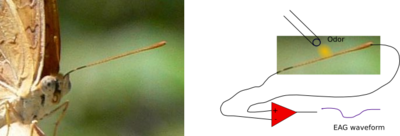
Electroantennography
Encyclopedia
Electroantennogram or EAG is a technique by which we measure the average output of the antenna
to the brain
for a given odor
. It is commonly used in the electrophysiology
while studying the function of olfactory pathway in insect
s. The technique was invented in 1957 by German biologist Dietrich Schneider.
EAG is performed in two ways:
 The technique is widely applied in screening of insect pheromone
The technique is widely applied in screening of insect pheromone
s by examining the responses to fractions of a compound mixture separated using chromatography
.
Usually the wire inserted into the antenna is a thin silver wire which is chlorided in bleach. This is an older practice. Commonly, tungsten
wires which have been chemically sharpened are inserted into a single neuron in the antenna.
Further detailed examination of the odor response at the olfactory sensory level can be done by sensilla recording.
Antenna (biology)
Antennae in biology have historically been paired appendages used for sensing in arthropods. More recently, the term has also been applied to cilium structures present in most cell types of eukaryotes....
to the brain
Brain
The brain is the center of the nervous system in all vertebrate and most invertebrate animals—only a few primitive invertebrates such as sponges, jellyfish, sea squirts and starfishes do not have one. It is located in the head, usually close to primary sensory apparatus such as vision, hearing,...
for a given odor
Odor
An odor or odour is caused by one or more volatilized chemical compounds, generally at a very low concentration, that humans or other animals perceive by the sense of olfaction. Odors are also commonly called scents, which can refer to both pleasant and unpleasant odors...
. It is commonly used in the electrophysiology
Electrophysiology
Electrophysiology is the study of the electrical properties of biological cells and tissues. It involves measurements of voltage change or electric current on a wide variety of scales from single ion channel proteins to whole organs like the heart...
while studying the function of olfactory pathway in insect
Insect
Insects are a class of living creatures within the arthropods that have a chitinous exoskeleton, a three-part body , three pairs of jointed legs, compound eyes, and two antennae...
s. The technique was invented in 1957 by German biologist Dietrich Schneider.
EAG is performed in two ways:
- Remove the antenna from the animal and insert two chlorided silver wires for contact onto the two ends and amplify the voltage between them while applying an odor puff to see a deflection as in the figure.
- Leave the animal intact and insert a ground wire (silverSilverSilver is a metallic chemical element with the chemical symbol Ag and atomic number 47. A soft, white, lustrous transition metal, it has the highest electrical conductivity of any element and the highest thermal conductivity of any metal...
/silver chlorideSilver chlorideSilver chloride is a chemical compound with the chemical formula AgCl. This white crystalline solid is well known for its low solubility in water . Upon illumination or heating, silver chloride converts to silver , which is signalled by greyish or purplish coloration to some samples...
) or a glass electrode filled with a buffer solution to some part of the body, usually inserted into an eye, and another to the tip of the antenna. A large bore glass electrode can also be placed directly over the tip of the antenna, such as in Drosophila melanogasterDrosophila melanogasterDrosophila melanogaster is a species of Diptera, or the order of flies, in the family Drosophilidae. The species is known generally as the common fruit fly or vinegar fly. Starting from Charles W...
(fruit fly) antenna recordings. The latter method is useful if one is doing an experiment on the animal as a whole while doing the antennogram.

Pheromone
A pheromone is a secreted or excreted chemical factor that triggers a social response in members of the same species. Pheromones are chemicals capable of acting outside the body of the secreting individual to impact the behavior of the receiving individual...
s by examining the responses to fractions of a compound mixture separated using chromatography
Chromatography
Chromatography is the collective term for a set of laboratory techniques for the separation of mixtures....
.
Usually the wire inserted into the antenna is a thin silver wire which is chlorided in bleach. This is an older practice. Commonly, tungsten
Tungsten
Tungsten , also known as wolfram , is a chemical element with the chemical symbol W and atomic number 74.A hard, rare metal under standard conditions when uncombined, tungsten is found naturally on Earth only in chemical compounds. It was identified as a new element in 1781, and first isolated as...
wires which have been chemically sharpened are inserted into a single neuron in the antenna.
Further detailed examination of the odor response at the olfactory sensory level can be done by sensilla recording.

